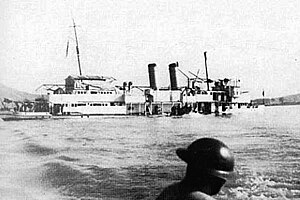| USS Panay incident | |||||||
|---|---|---|---|---|---|---|---|
| Part of the Second Sino-Japanese War | |||||||
 USS Panay sinking after Japanese air attack. Nanjing, China. | |||||||
| |||||||
| Belligerents | |||||||
|
|
| ||||||
| Commanders and leaders | |||||||
| James J. Hughes | unknown | ||||||
| Strength | |||||||
| 1 gunboat | 13 aircraft | ||||||
| Casualties and losses | |||||||
|
1 gunboat sunk 3 killed 43 wounded | 1 killed | ||||||
|
Civilian casualties: 2 killed, 5 wounded | |||||||
The USS Panay incident was a Japanese bombing attack on the U.S. Navy river gunboat Panay and three Standard Oil Company tankers on the Yangtze River near the Chinese capital of Nanjing on December 12, 1937. Japan and the United States were not at war at the time. The boats were part of the American naval operation called the Yangtze Patrol, which began following the joint British, French, and American victory in The Second Opium War. Public reaction was mixed in the U.S., with the president weighing various diplomatic and military responses only to settle for an apology and compensation.[1] The Japanese claimed that they did not see the U.S. flags painted on the deck of the gunboat. Tokyo officially apologized and paid a cash indemnity. The settlement mollified some of the U.S. anger, and newspapers called the matter closed.[2]
- ^ Douglas Peifer, “Presidential Crisis Decision Making Following the Sinking of the Panay,” Archived 24 December 2018 at the Wayback Machine International Journal of Naval History, vol. 14, nr. 2 (November 2018); Douglas Peifer, “The American Response to the Sinking of the USS Panay, December 1937.” In New Interpretations in Naval History: Selected Papers from the 2017 Naval History Symposium, ed. Brian VanDeMark. Annapolis MD: Naval Institute Press, 2023.
- ^ Walter LaFeber, The Clash (1997) p. 187.